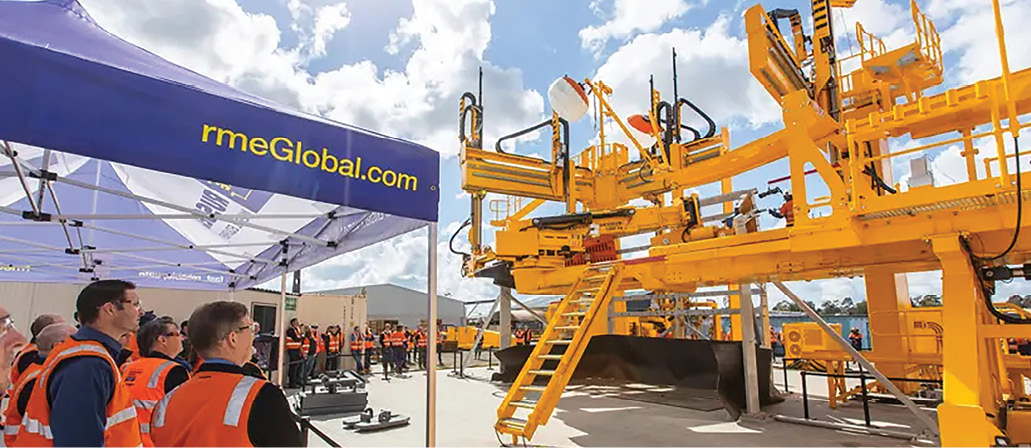Russell Mineral Equipment (RME) has successfully deployed the world’s first semi-automated roboticized mill relining system for safer, faster worn liner removal and new liner placement with no one inside the mill.
The mill relining systems manufacturer said the system will result in significant safety and commercial outcomes for its customer as well as the industry as a whole.
The reduction in mill relining risks and shutdown duration was achieved through a powerful combination of roboticizing RME’s mature and proven technologies; compatible liner and bolt design; and strong collaboration and change management with site management and reline crews.
RME’s automated system addresses the two main phases of mill relining: worn liner removal and new liner placement, and enables the completion of these necessary maintenance processes without anyone inside the mill. This system was developed and implemented in close collaboration with some of RME’s existing customers, including PT Freeport Indonesia.
RME founder, executive chairman and chief engineer John Russell described the new paradigm for fast, automated mill relines as the ultimate in safety and improved commercial performance for concentrators.

“RME’s goal has been to enable our customers to reline mills with no one inside, providing them with remarkable safety and efficiency benefits. By eliminating human-machine interaction, we can speed up the machines and relining processes, consistently and repeatably. This advanced capability is now a reality.”
The remarkable results achieved to date can be attributed to RME’s systems engineering approach. Safety inside and outside the mill was the priority and every step was carefully reviewed according to RME’s 24 Steps to Mill Relining Standard.
“We understood from our 35-plus years as an OEM that to safely automate mill relining, we would need to consider the many interdependent tasks across the entire process,” added Russell.
“The engineering result is now a tightly-integrated system of advanced modular technologies that automate manual repetitive tasks, eliminate risks and speeds-up relining.”
Consequently, RME’s automated system enables a staged implementation whereby upgrades happen within planned maintenance windows over multiple reline events. This ensures customers will not experience additional costly mill downtime scenarios.
One major advantage of RME’s semi-automated mill relining system is that its underpinning technologies are well-established and well-used by the industry.
Peter Rubie, who held the role of chief engineer at RME until 2019 and is a non-executive director at RME, played a key role in the development of the company’s automation technologies.
“Mining can be conservative when adopting new technologies, due to economic risk,” said Rubie.
“For some of our customers, even one hour of downtime can cost upwards of US$200,000 of production. We can avoid these impacts by automating existing proven systems.
“The beauty of RME’s mill relining technologies ecosystem is that the elements are modular and future-proofed. Miners of all sizes can deploy the base components and then incorporate additional automation steps at their own pace.”
The centerpiece of RME’s semi-automated mill relining system – the RUSSELL 7 Model R AutoMotion Mill Relining Machine (MRM) – is a highly advanced configuration of the industry’s most adopted 7-axis liner exchange machine, the RUSSELL 7 MRM.
It is complemented by Thunderbolt Skyway, a semi-automated knock-in system used on the exterior of the mill. Operational since 2020 at sites in Central America and Indonesia, Skyway is well-proven. This technology is now also available as a portable lift-in solution called Thunderbolt Skyport. It is another automation of RME’s established technology that increases asset utilization by being shareable between mills on-site.
These systems, working together with Insideout Technology tooling and compatible liner and bolt design, can grab knocked-in worn liners off the shell or from the charge, and place new liners against the shell with millimeter precision, and without personnel working inside the mill. The securing of liners, nuts and bolts from the mill’s exterior can also now be achieved using RME Boltboss.
RME has been collaborating with customers across several sites to progressively automate mill relining, including upskilling their customers’ local crews.
Analysis of historical reline shutdown data using conventional relining methods, compared with filmed data using some, but not all, of RME’s automated mill relining technology suite, reports a 65% risk reduction for activities inside the mill and 30% productivity uplift for a 38-foot SAG mill.
Following a staged implementation, PT Freeport Indonesia recently completed their first reline utilizing the combination of Thunderbolt Skyway and the Russell 7 Model R AutoMotion MRM.
While the performance data is currently being analyzed, early indications point to an even greater reduction in risk and increase in productivity than was originally targeted.
Director Metallurgy and Strategic Planning at Freeport-McMoRan (FCX) John Wilmot summed up the outcomes FCX are seeing as safer and faster mill relining at the recent SAG 2023 conference in Vancouver, Canada.
“PT-FI Indonesia has largely removed crew from inside the mill as we reline. While there are still a few residual activities where we need to enter, such as wash-down, we’re executing relines faster and safer than before. Mill relining is no longer on the critical path,” he said.
“RME’s modular systems approach enabled us to progressively implement the technology, which meant we could quantify the safety and productivity improvements at each reline event, even as the new technology was being deployed.
“The staged implementation also provided an opportunity to create strong buy-in from our reline crew. In our experience, when the crew is part of the optimisation journey, the change program is infinitely more successful. At PT-FI Indonesia, our reline crew has now taken full ownership of the process.”
Leveraging RME’s equipment and methodologies, as well as the compatible liner and bolt designs, the company’s crew has experienced the difference that automation can make.
“They’ve found it to be safer and faster, and they won’t go back to conventional methods. By collaborating closely with all the stakeholders involved, we are engineering the risk out of mill relining. We believe RME’s collaborative and staged approach can serve as a model for the mineral processing industry,” Russell said.
